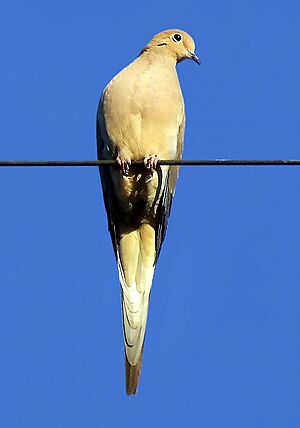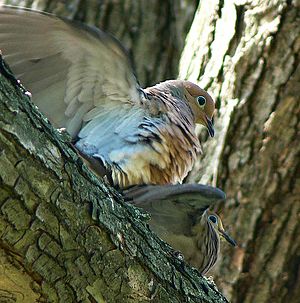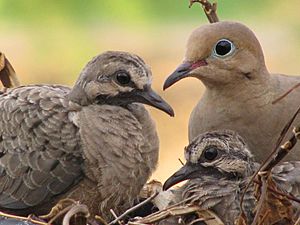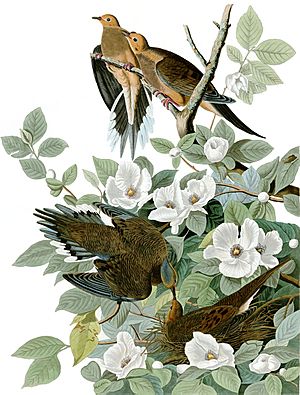Mourning dove facts for kids
Quick facts for kids Mourning dove |
|
|---|---|
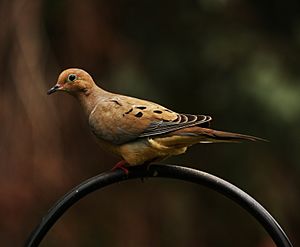 |
|
| Conservation status | |
| Scientific classification | |
| Kingdom: | |
| Class: | |
| Order: | |
| Family: | |
| Genus: |
Zenaida
|
| Binomial name | |
| Zenaida macroura (Linnaeus, 1758)
|
|
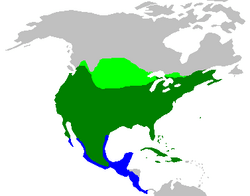 |
|
| Winter-only range Summer-only range Year-round range | |
The mourning dove (Zenaida macroura) is a common bird found in North America. It belongs to the dove family, Columbidae. There are about 475 million mourning doves, making them one of the most common birds.
These doves are light gray and brown. Male and female mourning doves look very much alike. They usually have one partner at a time. Both parents take turns sitting on the eggs and caring for their young. Adult mourning doves mostly eat seeds. The parents feed their babies a special "crop milk."
Mourning doves are known for their sad-sounding call, which is how they got their name. They are also very fast fliers, able to reach speeds of up to 88 kilometers per hour (55 miles per hour).
Contents
Where Mourning Doves Live
Mourning doves live in a very large area. This includes most of Mexico, the United States, and southern Canada. You can also find them in the Greater Antilles.
In summer, they are often seen in the Canadian prairies. In winter, they fly south to southern Central America. Sometimes, they wander to places like northern Canada, Alaska, and even South America. They have also been seen a few times in Europe. In 1963, some mourning doves were brought to Hawaii. A small group still lives there today.
These birds can live in many different places. They like farms, grasslands, and woods. However, they do not live in swamps or very thick forests. They also live near people, in cities and towns.
What Mourning Doves Look Like
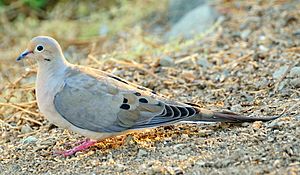
The mourning dove is a medium-sized, thin bird. It usually weighs between 110 and 170 grams (about 4 to 6 ounces). It has a small head and a long tail. Its feet are made for perching, with three toes pointing forward and one pointing backward. The legs are short and reddish. The beak is small and dark, a mix of brown and black.
Their feathers are mostly light gray-brown. Their underside is a lighter, pinkish color. Their wings might have black spots. The outer tail feathers are white. Their eyes are dark, with light skin around them. Adult males have bright purple-pink patches on the sides of their neck. This pink color extends to their chest. Young birds look a bit darker and have a more "scaly" look.
There are five different types, or subspecies, of mourning doves. They all look very similar. It is hard to tell them apart just by looking. For example, the Western subspecies has longer wings and a longer beak. The Panama mourning dove has shorter wings and legs. The Clarion Island subspecies has larger feet and a darker brown color.
Mourning Dove Sounds
The mourning dove's most famous call sounds like cooOOoo-woo-woo-woooo. Males use this sound to attract a mate.
Other sounds include:
- A nest call (cooOOoo) used by males to invite their mates to the nest.
- A greeting call (a soft ork) when males rejoin their mates.
- An alarm call (a short roo-oo) used by either male or female when there is danger.
When they fly, their wings make a soft, whistling sound. This sound is quiet, but it gets louder when they take off or land.
Reproduction and Life Cycle
The male mourning dove starts courtship by flying noisily. Then, he glides in a graceful circle with his wings spread and head down. After landing, the male walks toward the female. He puffs out his chest, bobs his head, and makes loud calls. Once a pair has formed, they often preen each other's feathers. Mourning doves are loyal to their partners. Sometimes, they stay together all winter. However, if a dove loses its partner, it will find a new one.
After mating, the male shows the female possible nest spots. The female chooses one and builds the nest. The male gathers twigs, pine needles, or grass. He brings these materials to the female. He stands on her back to give her the materials, and she builds them into the nest. Sometimes, mourning doves use old nests made by other birds or even squirrels.
Most nests are in trees. They can also be found in shrubs, vines, or on buildings and hanging flower pots. If there are no good spots above ground, they will nest on the ground. The nest is usually just big enough for two eggs. Sometimes, a female might lay her eggs in another pair's nest, leading to three or four eggs. The eggs are small and white.
Both parents take turns sitting on the eggs. The male sits from morning to afternoon. The female sits for the rest of the day and at night. Mourning doves rarely leave their nest empty. The eggs hatch after two weeks.
Both parents feed their babies, called squabs, a special "crop milk" for the first 3–4 days. After that, the squabs slowly start eating seeds. Their feathers and wing muscles grow quickly. They are ready to fly in about 11–15 days. Even after they can fly, the father continues to feed them for up to two more weeks.
Mourning doves breed very quickly. In warm areas, they can have up to six groups of babies in one season. This fast breeding is important because they do not live very long. Each year, about 58% of adult doves and 69% of young doves do not survive.
| Hatching and growth | |||
|---|---|---|---|
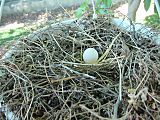 |
 |
 |
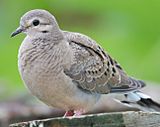 |
| Egg in nest | Nesting in progress | Squabs | A juvenile (young) mourning dove |
What Mourning Doves Eat
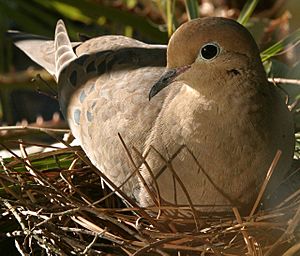
Mourning doves eat almost entirely seeds. Seeds make up at least 99% of their diet. Very rarely, they might eat snails or insects. Mourning doves usually eat until their stomach is full. Then, they fly off to rest and digest their food. They often swallow small pieces of gravel or sand to help them digest seeds.
At bird feeders, mourning doves like corn, millet, and sunflower seeds. They do not dig or scratch for seeds. They only eat what they can see on the ground. Sometimes, they will perch on plants and eat seeds directly from them. They especially like pine nuts, sesame, and wheat. If they cannot find their favorite foods, they will eat seeds from other plants like buckwheat and rye.
Mourning doves can get sick from different parasites and diseases. These include tapeworms, nematodes, mites, and lice. A parasite called Trichomonas gallinae is very serious. It lives in the bird's mouth and throat. Sometimes, the bird shows no signs of illness. But often, it causes a yellowish growth that can make the bird unable to eat, leading to starvation.
The main predators of mourning doves are birds of prey, like falcons and hawks. When they are nesting, their eggs might be eaten by corvids (like crows), grackles, house cats, or rat snakes.
Mourning Dove Behavior
Like other doves, mourning doves drink water without lifting their heads. They often gather at watering spots around dawn and dusk.
Mourning doves clean themselves by bathing in the sun or rain. They can also take baths in shallow pools or bird baths. Sometimes, they will even bathe in dust.
These birds are strong fliers. They can fly up to 88 kilometers per hour (55 miles per hour).
When they are not breeding, mourning doves sleep together in dense deciduous trees or conifers. When they sleep, their head rests between their shoulders, close to their body. It is not tucked under their wing feathers like many other birds do. Sometimes, in colder winter days in Canada, they might delay going to sleep.
Conservation Status
The mourning dove is not in danger. The International Union for the Conservation of Nature (IUCN) lists it as a species of Least Concern. This means it is not at immediate risk. There are about 475 million mourning doves, and they live across a very wide area. However, around 40–70 million birds are harvested as game each year.
Types of Mourning Doves
The mourning dove is closely related to the eared dove and the Socorro dove. Some scientists used to think the Socorro dove was the same species as the mourning dove. But now we know they are different because of how they act, their calls, and how they look.
There are five different types, or subspecies, of mourning dove:
- Eastern Z. m. carolinensis
- Clarion Island Z. m. clarionensis
- West Indian Z. m. macroura
- Western Z. m. marginella
- Panama Z. m. turturilla
The West Indian subspecies lives in the Greater Antilles and the Florida Keys. The Eastern subspecies lives mostly in eastern North America, Bermuda, and the Bahamas. The Western subspecies lives in western North America and parts of Mexico. The Panamanian subspecies is found in Central America. The Clarion Island subspecies lives near the Pacific coast of Mexico.
The mourning dove is sometimes called the American mourning dove. This helps tell it apart from the African mourning dove, which is not closely related. It was also once known as the Carolina turtledove. The scientific name, Zenaida, was given in 1838 by a French zoologist named Charles L. Bonaparte. He named it to honor his wife, Princess Zénaide. The "mourning" part of its name comes from its sad-sounding call.
Closest Relative
Scientists believe the mourning dove is most closely related to the extinct passenger pigeon.
Mourning Doves in Art and Culture
The Eastern mourning dove is the official symbol of peace for the state of Wisconsin. It is also Michigan's state bird of peace.
The mourning dove appears in famous artworks. For example, it is shown as the Carolina turtle-dove in plate 286 of Audubon's book The Birds of America.
Mourning doves are often mentioned in American literature. They appear in poems by American and Canadian writers like Robert Bly, Jared Carter, Lorine Niedecker, and Charles Wright.
Images for kids
-
Mourning dove in Guelph, Ontario, Canada.
See also
 In Spanish: Huilota común para niños
In Spanish: Huilota común para niños



